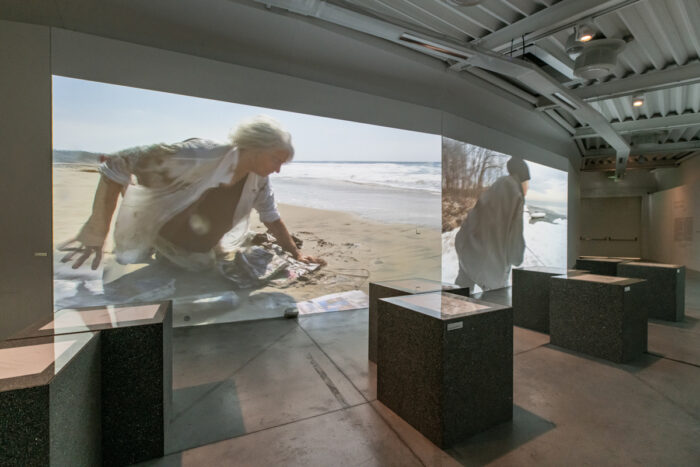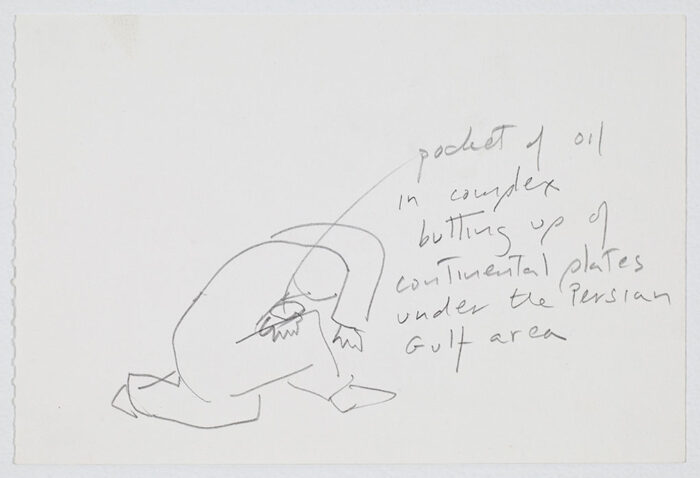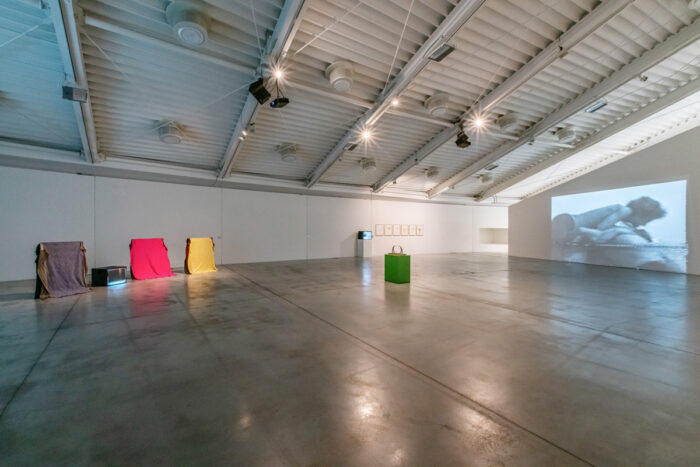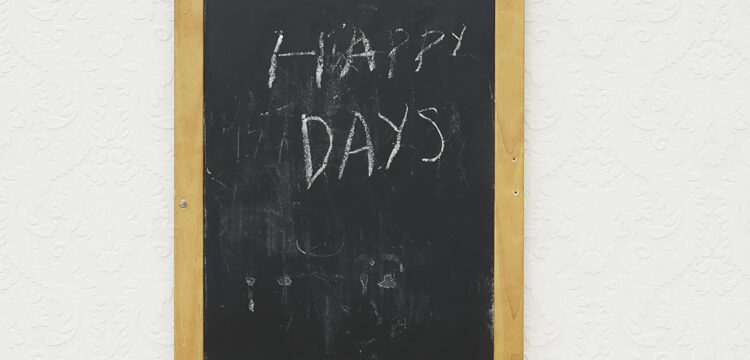Hush Hush
Sweet Simone. An excerpt from Simone Forti’s “News Animations”
An internationally renowned artist, a key figure in the development of performance from the late 1950s to the present, Simone Forti moved to Los Angeles in 1938 with her family, originally from Prato. Her seminal work was the focus of her first major exhibition in an Italian museum: Senza fretta curated by Luca Lo Pinto and Elena Magini.
Since the 1960s, Simone Forti has moved forward with a pioneering and experimental approach based on the experience of the body as a means of obtaining knowledge. Her work takes form in a vast range of different media, from painting to drawing, video to sound. Nevertheless, physical expression practiced through dance, and particularly the body’s ability to improvise, represents the fundamental key of her oeuvre.
The exhibition focuses on the News Animations, a series of works developed starting in the mid-1980s, in which the artist analyzes the relationship between language, movement and physicality, taking cues from articles found in newspapers. The News Animations are performances, where Forti embodies current events through movement and improvisation: the perception of the news from reports is mediated and explored in terms of pressure, weight and balance, just as the language of newspapers takes on terminology pertaining to various physical dynamics.
The exhibition catalogue (NERO, 2021) collects Simone Forti’s News Animations from 1980 to 2018 – through the transcriptions of the performances, images, and drawings – seeking to capture their spirit, their poetic stance and, mostly, understand how they manage to describe the society and the world we live in. The volume is co-produced by the Centro per l’arte contemporanea Luigi Pecci, Prato. Here, the introduction to the catalogue written by Luca Lo Pinto.
Ever since the archaeological area of Largo Argentina in Rome was opened to the public in 1929, various generations of cats have found a natural habitat amidst the ruins of ancient temples, where they still camp out, eat, sleep, play and stretch their muscles. In 1968, Simone Forti stayed in Rome for a few months, and spent lots of time observing and photographing those cats. The images were stored away for many years, and the artist has decided to exhibit them only recently, as photographs and in a form more akin to an installation, featuring slides projected onto a sheet moving in the wind.
Largo Argentina is a location indirectly connected with Forti’s family history. The archaeological area was, in fact, inaugurated by Benito Mussolini at the height of his dictatorial ascent: the very person whose enactment of race laws forced the migration of the artist and her family from Italy, since they were Jews.

The first three years of Simone Forti’s life were in Florence, her birthplace in 1935. Her father Mario came from Prato, where in the 1800s her grandfather Beniamino had founded an important textile firm, specializing in the production of regenerated wool. Her mother, Milka, was instead from a Jewish family of Eastern Europe. When in December 1938 Mario read the announcement “no more passports being issued to Jews” in the newspaper, he understood that flight was the only option. Pretending departure for a winter vacation, Simone left Florence together with her parents and her sister Anna, dressed for skiing. A dramatic journey, which in one fell swoop deprived the family of citizenship and a life (little Nicoletta died in infancy). After six months in Bern, they set off for America, moving to Los Angeles, where Simone still resides today.

The personal and professional history of Simone Forti has deep ties to Italy. It is her mother tongue, the land of her birth, but it is also the place that rejected her. In this sense, the exhibition in Prato is a homecoming, a reunion with her Heimat, “without haste.” When we were together in her house in Los Angeles, opening a book of poems by her beloved William Carlos Williams and choosing a page at random, without looking Simone aimed a finger at precisely these two words—“without haste”—which jibe perfectly with her ode to the light of heart, the desire to be free of constraints, the thrill of letting oneself be guided by something other-than-self. If among all the media she has utilized that of the exhibition is perhaps the one she loves least, I think this might be due to the fact that exhibitions are traditionally static, having a definition, a spatial and temporal determination in total antithesis to movement, to the workshop approach, to the improvisation that exists in Simone’s DNA.

Preparing the exhibition at the Centro per l’arte contemporanea Luigi Pecci (the occasion for which this book was published), rather than concentrating on the exhibition format, with Simone we thought about an attempt to observe her research by focusing on the News Animations series and using it as a key of interpretation for wider-ranging reflections. News Animations is the work that best reveals one of Simone Forti’s main interests: the exploration of the potential of language in a total dimension, combining movement, words, images and music.

Unlike Simone, her father Mario loved reading newspapers. It was an everyday ritual that saved their family, when he understood the gravity of the Italian government’s threat to Jews and decided to leave the country in great haste. When her father passed away in 1983 it was a difficult moment for Simone, on a personal level, following the separation from her third husband, Peter Van Riper. She was rethinking the direction of her research. In a sort of catharsis, to get beyond the grief of the loss of her father, she began to “read” the news in his stead, absorbing it and giving rise to one of her most intimate works: News Animations.

While the Dance Constructions stemmed from the intellectual and artistic concern to find her own position in the world of dance, the News Animations originated from conflicts on a personal plane. In the 1980s Forti concentrated above all on teaching, conducting workshops around the world. One in particular, titled Work in Progress and produced in 1985, was aimed at people who were going through a transitional phase in their lives and were uncertain about what they should do. One of the participants was Berenice Fisher, a student who had stopped reading newspapers and wanted to return to doing so in a more intimate way, through movement. This revelatory encounter enabled Forti to enrich her vocabulary. After the Dance Constructions and the choreographies influenced by the study of animals, in News Animations she constructed an improvisation based on the combination of movement and speech. She introjected and humanized news items, mostly regarding the most urgent issues of the global socio-political situation, letting the mind communicate with the body in a form that is expressed both with movement and with words, also extending into a series of drawings gathered under the same title. If moving corresponds to painting and speaking to drawing, News Animations is drawn painting. Through free association of meaning, the artist grants voice and body to thoughts about the world in a stream of consciousness that feeds on a frenetic combination of images, memories, information stimulated by news media.
In a world where social networks have replaced information and newspapers themselves have lost their physicality, the News Animations series is particularly timely and illuminating, and reveals a political dimension in Forti’s practice that is more explicit with respect to the past. The idea of interpreting, animating and returning the news presented to us by the media is an invitation to action and to reject a passive interpretation, a call to take back control of the world around us and to explore it in a personal, absolute way. In a moment in which History manifests itself as an increasingly fragmented puzzle of distant and diverse stories, emotions and experiences, Forti blends them together, granting form and expression to the jagged perception of our lives and pursuing a non-logical but experiential approach.

To improvise starting with an arbitrary object (like a newspaper) that can help to suggest thoughts to translate into dance is perhaps the most precious lesson gleaned from the studies with Anna Halprin. With her, the artist learned to work on improvisation based on a kinesthetic dimension that favors feeling over seeing. Halprin held her workshops on a wooden platform set up in the forest around her home, and she often invited her students to find a source of inspiration in any element of their surroundings, building movements upon it. A continuing process of experimentation and total learning, from the study of anatomy books to the investigation of certain physical movements, from the relationship with space to the accompaniment of music or spoken words. The awareness that every movement has a specific quality deserving exploration was decisive in Forti’s background and in that of other artists of her generation (Trisha Brown, Steve Paxton, Yvonne Rainer). In her countless visits to the zoo, she observes movements produced by physical structures different from her own, and constructs a vocabulary starting from that point. From the outset, Simone has manifested an interest and fascination with the non-human dimension. From this viewpoint, working with the news or gaining inspiration from animals is synonymous with a desire to transcend disciplinary boundaries and to enact another way of being in the world and relating to the world.
This book does not set out to thematize a work like News Animations, but to convey its spirit, acting as a landscape of associations among thoughts, words, memory, politics, life and art, enlivened by the combination of drawings, photographs, video stills and texts. A flow of contents that in the passage from the live dimension to the written resembles a seesaw, where the weights are naturally balanced between body and words, physical mind and verbal mind.

Though known primarily for her crucial role in the context of avant-garde dance, limiting Forti’s work to this field is absolutely reductive. She is an artist tout court, totally beyond categories, capable of surprising us for her ability to experiment with the body and with language, sound or writing. Were we to attempt to interpret all of her work, as an exercise, addressing a different medium case by case (sculpture, drawing, dance, sound, writing) as our key, it becomes clear that she has radically disrupted and expanded the limits of all those disciplines. So the widespread though belated recognition of her seminal impact, generated through research based on the fluidity and interaction of languages now common among the younger generations, should come as no surprise. An art based on improvisation, which cannot be reconciled with the paradigms of a system that only today, and with problematic aspects, attempts to incorporate—winding up by materializing and objectifying—that dematerialization that is shared by practices whose ultimate goal does not coincide with the production of an object, but with that of an experience. Not by chance, Forti once admitted that “I feel I do my most beautiful work in the studio situation, and I would be happy to keep it there,” acknowledging that her work from 1960 to the present is essential based on “a certain sensitivity, presence, experience, first-hand knowledge.” News Animations is a manifesto of this attitude.

Simone has never been tolerant of teachings, of rules. Her works and her history are in eternal movement. Faithful to her vocabulary, she likes the possibility that everything can be modified and revised. The past is the other side of the future, depending on how you turn the coin. To fix or limit it to one side would imply caging it, like an animal in captivity.
In spite of the apparent fragility of an ageing body, the specific gravity of Simone Forti in the world of art is incalculable. A tireless little boulder, a body which in its diligence, sobriety and determination stands up to the broadsides of a system bent on imposing order and smoothing over differences. Forti is an ode to resistance and poetry. Like her small house that is still standing amidst the skyscrapers of Westwood.



